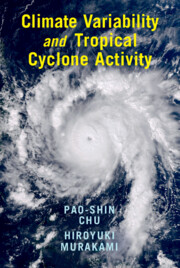Book contents
- Climate Variability and Tropical Cyclone Activity
- Climate Variability and Tropical Cyclone Activity
- Copyright page
- Contents
- Preface
- Abbreviations
- 1 Introduction
- 2 Climate Variability. Part I: Intraseasonal Oscillation
- 3 Climate Variability. Part II: Interannual to Interdecadal Variability
- 4 Climate Variability and Tropical Cyclones
- 5 Subseasonal to Seasonal Tropical Cyclone Prediction
- 6 Extreme Typhoon Rainfall Under Changing Climate
- 7 Future Tropical Cyclone Projections and Uncertainty Estimates
- Index
- References
6 - Extreme Typhoon Rainfall Under Changing Climate
Published online by Cambridge University Press: 17 February 2022
- Climate Variability and Tropical Cyclone Activity
- Climate Variability and Tropical Cyclone Activity
- Copyright page
- Contents
- Preface
- Abbreviations
- 1 Introduction
- 2 Climate Variability. Part I: Intraseasonal Oscillation
- 3 Climate Variability. Part II: Interannual to Interdecadal Variability
- 4 Climate Variability and Tropical Cyclones
- 5 Subseasonal to Seasonal Tropical Cyclone Prediction
- 6 Extreme Typhoon Rainfall Under Changing Climate
- 7 Future Tropical Cyclone Projections and Uncertainty Estimates
- Index
- References
Summary
Extreme events, such as heavy precipitation and flooding associated with tropical cyclones, are a major concern because of their devastating consequences on society and economics. For instance, a heavy downpour in a short time span resulting from TCs can trigger landslides and mudslides in mountainous regions. This may lead to property and infrastructure damage, loss of human and animal life, along with severe environmental degradation. Densely populated areas such as major cities are also at a high risk for flash floods from TCs because the construction of buildings and roads in cities reduces the absorption capacity of the ground and, as a result, runoff of floodwater is increased. Torrential rainfall can also leave storm drains suddenly overwhelmed, resulting in floodwater spilling onto roads, buildings, and residential dwellings. Low-lying areas such as parking lots, building basements, underpasses, and subway stations are particularly vulnerable to such rapidly rising water. A short burst of intense rainfall, not necessarily related to the TC categorization according to the common sustained wind strength, often causes significant damage.
- Type
- Chapter
- Information
- Climate Variability and Tropical Cyclone Activity , pp. 236 - 257Publisher: Cambridge University PressPrint publication year: 2022



